|
|
Trio Sonatas BWV 525-530
Provenance |
|
Provenance |
|
Original Sources (upon which all subsequent copies are based):
The two key primary sources containing the complete set of the organ sonatas are located in the BB (Staatsbibliothek Berlin) as MS P 271 (listed by the NBA KB for greater clarity and easier reference as “A”) and MS P 272 (listed as “B”).
Background on P 271 (A)
The first, P 271 is described as a Sammelhandschrift (a ‘manuscript collection’) consisting of autograph copies of BWV 525-530 (The Six Organ Sonatas), BWV 651-667 (The 17 {Organ} Chorales – This grouping is also referred to as the “Leipzig” or the “Eighteen”- actually Bach’s autographs include only BWV 651 to 665 – Altnickol later copied BWV 666 and BWV 667 on the remaining empty pages) and BWV 769 (The Canonic Variations).
Comparing the watermarks with those appearing in paper types used by Bach for his cantatas, Alfred Dürr in his Zur Chronologie der Leipziger Vokalwerke J. S. Bachs, 2nd Edition, 1976, pp. 138ff. indicated that the paper used for P 271 can be directly linked to cantatas and other vocal works composed during the period from Oct. 17, 1727 to Dec. 2, 1731. According to Georg von Dadelsen in his Beiträge zur Chronologie der Werke Johann Sebastian Bachs, from the Tübinger Bach-Studien, Trossingen, 1958, his handwriting analysis would place the time when Bach wrote out his manuscript of the organ sonatas as “mit einiger Sicherheit auf etwa 1730” (“with some degree of certainty circa 1730”). However, in his careful analysis of Bach’s handwriting found in the NBA X/2 (1989) completed over 30 years later, Yoshitake Kobayashi was unable to ascertain such a precise dating and concluded simply that the aforementioned organ sonatas are representative of Bach’s penmanship during the period 1727-1732.
Specific Provenance of MS P 271 (A)
Carl Philipp Emanuel Bach inherited this manuscript (collection) in 1750 at the time of the distribution of his father’s estate. It can be assumed that it remained in C.P.E. Bach’s possession until his death in 1790 when his widow offered for sale the contents of his music collection in the Verzeichnis des musicalischen Nachlasses des verstorbenen Capellmeisters Carl Philipp Emanuel Bach (A List of the Musical Items in the Estate of the Deceased Capellmeister Carl Philipp Emanuel Bach). In this booklet printed in Hamburg in 1790, P 271 is listed as follows:
Sechs Trios mit 2 Clavieren und Pedal und ohngefehr 20 Vorspielen und ausgeführten Choräle für die Orgel. Von der eigenen Hand des Verfassers [Six Trios for 2 Claviers and Pedal and Approximately 20 Chorale Preludes for the Organ. In the Composer’s Own Handwriting].
This manuscript collection (P 271) then came into the possession of a Bach manuscript collector, Georg Poelchau (1773-1836). In his handwritten catalogue dated 1832, it is described as follows under the category, Für Klavier und Orgel [For Keyboard and Organ]:
a) Sechs Orgel=Trios für 2 Manuale und Pedal (Es, d, C m. D m. E m. C d. G m.) Eines der größten Meisterwerke.
b) Zwanzig Vorspiele und ausgeführte Choräle für die Orgel.
Beides von eigener Hand.
27 Bg.
[a) Six Organ Trios for 2 Manuals and Pedal (in Eb major, D minor, C minor, D minor, E minor, C major and G minor). One of the greatest masterworks.
b) Twenty Chorale Preludes and Chorales realized for performance on an organ.
Both in the composer’s own handwriting.
27 folio pages.]
Poelchau also placed a separate page at the beginning of P 271 which reads:
Sechs Orgel=Trios…Achtzehn noch ungedruckte | Choralvorspiele… [Six Organ Trios…Eighteen still unpublished Chorale Preludes…] [The word ‘eighteen’ had been changed from either ‘seventeen’ or ‘twenty’.]
After Poelchau’s death in 1836, the BB (Staatsbibliothek Berlin) acquired his entire collection of Bach manuscripts.
Background on P 272 (B)
This manuscript, P 272, also contains all six of the organ sonatas; however, none of these were copied by J.S. Bach, despite the fact that they were considered autograph by some early 19th -century Bach biographers and scholars. In reality, recent careful analysis has uncovered that there were actually two copyists involved in preparing this manuscript: Wilhelm Friedemann Bach was responsible for Sonatas 1 to 3 and the beginning of 4 (the first 15 bars of the first movement). The rest of the manuscript was copied by Anna Magdalena Bach.
The watermarks visible as MA (or AM as viewed from another side of the page) were also used by J.S. Bach for his vocal works composed in the period from July 6, 1732 until February 2, 1735. On August 1, 1733, W.F. Bach left Leipzig to assume a position as organist at the Sophienkirche in Dresden. It is more likely that W.F. Bach did not receive this manuscript after his father’s death in 1750, but rather took it with him to Dresden in 1733 for performances of this music there.
The NBA KB has an extended discussion on details surrounding the authorship and sequence of the copying process. Friedrich Konrad Griepenkerl (1782-1849), editor of the C. F. Peters publication of the complete edition of the organ sonatas in 1844, originally thought it was a genuine autograph throughout. Wilhelm Rust (1822-1892) responsible for the BG XV (1867) discovered that the first section was not an autograph, but rather was copied by W.F. Bach; but, nevertheless, he still affirmed that the remaining section was an autograph when he prepared his BG volume. In his Bach biography (vol. 2, p. 692, footnote 178), Philipp Spitta (1841-1894) finally set the record straight by pointing out that Anna Magdalena Bach had copied the rest and that J.S. Bach was responsible for only a few additions in this manuscript. It is clear from the evidence today that P 272 (B) is a copy prepared on the basis of the original P 271 (A) and that J.S. Bach only added a few titles and tempo designations to P 272 (B) after it had been completed.
Based on more recent research, it appears that the portion of P 272 (B) that Anna Magdalena Bach had copied was completed before the portion copied by W.F. Bach. Very likely she had, at an earlier point in time (not before July 6, 1732, however, due to the time limit imposed by the watermark analysis), prepared a copy of all six of the organ sonatas based upon (copied from) J.S. Bach’s autograph (fair or clean) copy listed as P 271 (A). It is unclear what may have happened to the missing sonatas certainly copied by Anna Magdalena Bach, but which W.F. Bach later had to recopy in order to obtain a complete set of them.
Specific Provenance of MS P 272 (B)
The sequence of ownership of this manuscript is as follows:
1. Wilhelm Friedemann Bach probably took it with him when he left Leipzig to resettle in Dresden in 1733.
2. In a note he added to his personal copy of Forkel’s Bach biography, Friedrich Konrad Griepenkerl (1782-1849), indicated that W.F. Bach had given it to Johann August Müller (1731?-1784), a convent curate in Braunschweig. It was Müller who had given W.F. Bach a place to live from 1771-1774 when he resided in Braunschweig. 1774 could possibly have the occasion for W.F. Bach to express his gratitude to Müller by giving him P 272 in April of that year before leaving Braunschweig to go to Berlin where W.F. Bach lived until his death in 1784.
3. Griepenkerl acquired it at an undetermined date and it was sold after his death in 1849 via A. Ascher and Co., Berlin to the BB (Staatsbibliothek Berlin) where it is still located today.
The Myth That Bach Composed the Organ Sonatas for His Son, Wilhelm Friedemann Bach
It was Johann Nikolaus Forkel (1749-1818) who stated in his Bach biography (1802): “Bach hat sie [die Sechs Sonaten or Trio für zwey Claviere mit dem obligaten Pedal] für seinen ältesten Sohn, Wilh. Friedemann, aufgesetzt, welcher sich damit zu dem großen Orgelspieler vorbereiten mußte, der er nachher geworden ist” [“Bach wrote down his Six Sonatas or Trios for Two Claviers and obbligato Pedal for his oldest son, Wilhelm Friedemann, who would use them to prepare himself to become a great organist, which he later did become.”] Comment on the translation from the German: “aufsetzen” means “specifically to provide a sketch, put down on paper as a first draft but not in its final form” = this begins to sound very much like Forkel, relying most likely upon personal communication with Carl Philipp Emanuel Bach, who possessed the only genuine autograph, thought that J.S. Bach had ‘composed’ them for W.F. Bach. Griepenkerl, who inherited Forkel’s personal, annotated copy of his own Bach biography and who received P 272 (B) as a present from Müller, commented as follows in his preface to the Peters I edition in 1844:
“Von den sechs Sonaten oder Trio’s weiss man, dass der Meister sie für seinen ältesten Sohn W. Friedemann Bach in Leipzig nach 1723 geschrieben hat….” [“Regarding the six sonatas or trios, it is known that the master {J.S. Bach} wrote them for his oldest son, Wilhelm Friedemann Bach after 1723 in Leipzig….”]
The NBA KB IV/7, p. 15, concludes that Forkel’s assertion (1802), repeated and interpreted by Griepenkerl (1844), that the organ sonatas were originally composed for Wilhelm Friedemann Bach as practice and/or performance pieces is not borne out by all the evidence that has been assembled since that time. What can be maintained presently is that the autograph P 271 (A) is the first compilation or assemblage into a unified set of a number of individual sonatas or sonata movements that had already been previously composed as far back as during Bach’s years in Weimar (1708-1717).
The Quality of Bach’s Handwriting (P 271)
A description of Bach’s handwriting can reveal whether a score is a ‘composing’ score or not. The NBA KB describes P 271 as follows: “Die meisten Sätze liegen in P 271 in einer nicht ganz korrekturlosen Reinschrift vor” [“Most of the movements in P 271 can be characterized as a ‘clean’ copy with only a few corrections”]. To a great extent the versions presented in P 271 are based upon earlier versions: Frühfassungen. |
| |
|
Headings and Tempo Indications in P 271 and P 272 |
|
The headings and tempo indications are generally the same with the following exceptions:
1. J.S. Bach’s manuscript begins with “J.J.” [Jesu Juva] before Sonata I and ends with “Il Fine dei Sonate” at the end of Sonata VI. (P 272 simply has a “Fine” after each sonata (except “Il Fine” after Sonatas I and II and nothing at all after Sonata V).
2. The headings generally read “Sonata # (fill in the numbers 1 through 6 usually followed by a period) à 2 Clav: et Pedal. di J.S.Bach”. For his portion (Sonatas 1 to the beginning of 4), W.F. Bach omits the name of the composer: J.S. Bach entirely.
3. There are a few minor inconsistencies involving the period after the number, Anna Magdalena Bach spelling out completely “Clavier” or J.S. Bach using “e” or “&” in place of “et”.
The tempo indications are essentially the same in both manuscripts with the following important exceptions:
1. Sonatas II/1, III/1, IV/1, 2 have tempo indications in P 271 with do not appear in P 272
2. Sonata VI/1 has no tempo indication in P 271 but P 272 has a “Vivace”. |
|
Sonata #/mvt.# |
P 271 (A) autograph |
P 272 (B) copy which Bach checked over |
|
BWV 525/1 |
----- |
----- |
|
|
BWV 525/2 |
Adagio |
Adagio |
|
|
BWV 525/3 |
Allegro |
Allegro |
|
|
BWV 526/1 |
Vivace |
----- |
|
|
BWV 526/2 |
Largo |
Largo |
|
|
BWV 526/3 |
Allegro |
Allegro |
|
|
BWV 527/1 |
Andante |
----- |
|
|
BWV 527/2 |
Adagio é dolce |
Adagio é dolce |
|
|
BWV 527/3 |
Vivace |
Vivace |
|
|
BWV 528/1 |
Adagio |
----- |
|
|
BWV 528/1 |
vivace |
----- |
|
|
BWV 528/2 |
Andante |
Andante |
|
|
BWV 528/3 |
un poc’ allegro |
Un poc allegro |
|
|
BWV 529/1 |
Allegro |
Allegro |
|
|
BWV 529/2 |
Largo |
Largo |
|
|
BWV 529/3 |
Allegro |
Allegro |
|
|
BWV 530/1 |
----- |
Vivace |
|
|
BWV 530/2 |
Lente |
Lente |
|
|
BWV 530/3 |
Allegro |
Allegro |
|
|
All other tempo designations are not authentic and spring from the imagination of later editors and performers. |
| |
|
Manuscript Additions and Corrections:
Some of the additions to P 272 such as those involving ornamentation and articulation appear to have been undertaken by J.S. Bach after this manuscript was completed such as when a short Pralltriller (mordent) is changed into a long one. As far as the process of correcting mistakes generally goes, whether occurring in P 271 or P 272, most of these can be considered to be corrections made in statu scribendi. Only in a few cases is it doubtful whether they were made by someone else at a later time.
Keyboard and Pedal Ranges
In addition to the conclusions about the time frame during which these organ sonatas were composed, conclusions that can be reached based upon Bach’s handwriting, watermarks in the paper used, etc., it is also possible to examine the music itself for clues that help to substantiate that almost all of these compositions were by no means original conceptions circa 1730 but rather originated from earlier periods in Bach’s life. One investigative method involves the discovery of instances of Oktavbrechung or Oktavversetzung (moving the musical line or melody up or down an octave to accommodate the limits imposed by the range of keyboards, pedals, other instruments, or even voices).
It is a fact that both key manuscripts, A and B, adhere strictly to specific ranges throughout all the sonatas: the manuals go from a low C, then D all the way up through c’’’ and the pedal from a low C, then D all the way through, but not beyond, a high d’. These were the prevailing ranges for instruments that were generally available during Bach’s Leipzig period when both manuscripts were completed. It would appear that Bach was now compiling these organ sonatas with the idea of public distribution in mind. Since many Frühfassungen (earlier, previous versions) of these sonatas still exist, it is possible to see how Bach changed the melody lines in order to avoid going beyond the prescribed limits he had adopted for his compilation of them. Also, for those sonatas for which a Frühfassung no longer exists, a search for Oktavbrechung will help to substantiate the earlier existence of the music either as an organ piece playable on an organ from an earlier period with a larger range or a even as an instrumental compositions involving various instruments. As the NBA KB on p. 65 puts it: “Die Beobachtung auffälliger Rücksichtnahme auf den Klaviaturumfang gestattet…also auch dann gewisse Rückschlüsse auf die Frühgestalt einiger Sätze des Zyklus, wenn die betreffende Frühfassung nicht mehr erhalten ist.” [“By observing the obvious consideration paid to the keyboard range it is then possible to draw certain about the earlier stage of several movements of the cycle in those instances where an earlier version is no longer extant.”] |
| |
|
Examples of the above: |
|
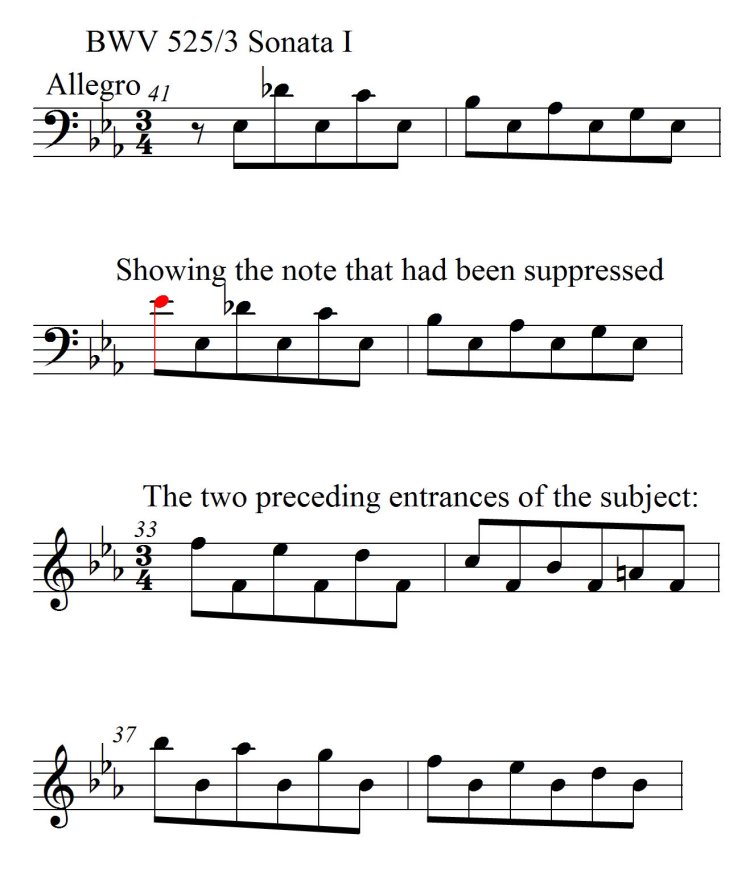
|
|
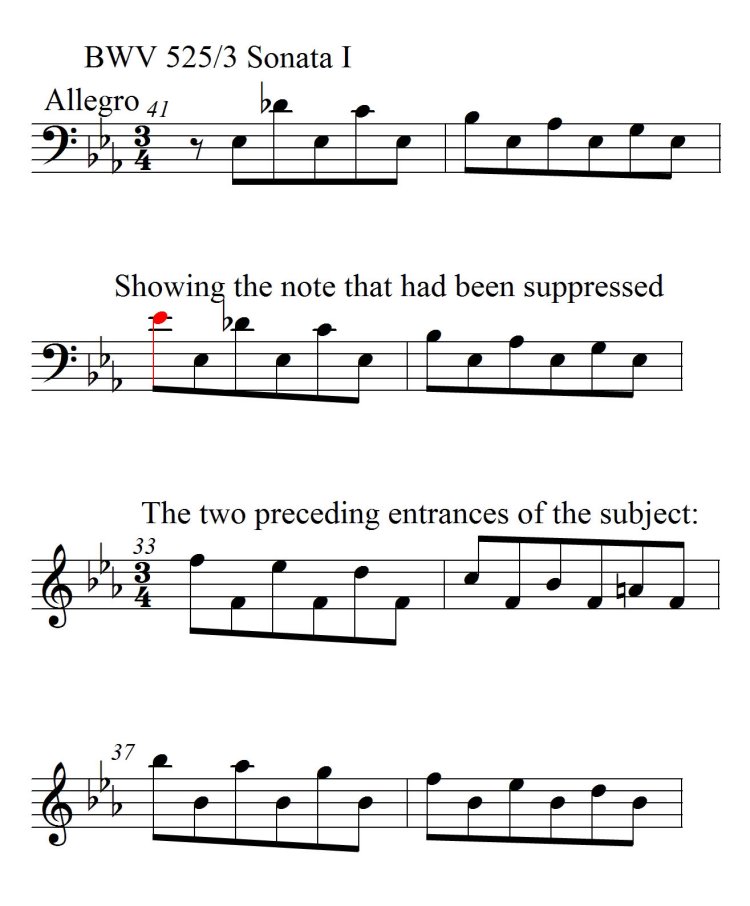
|
|
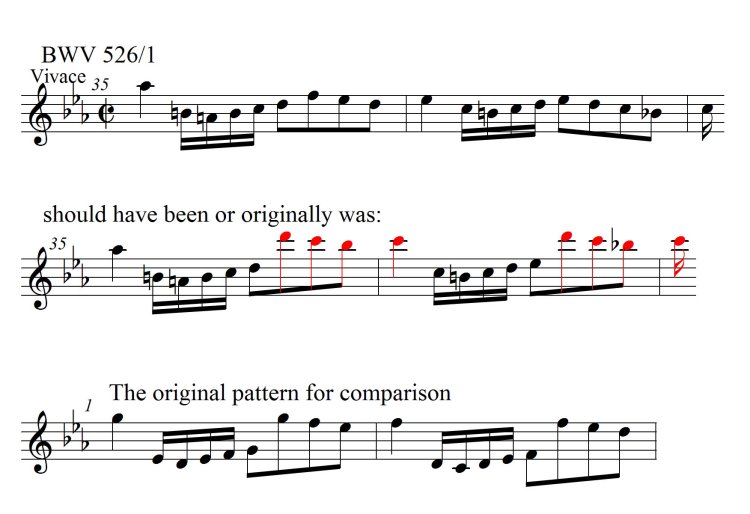
|
|
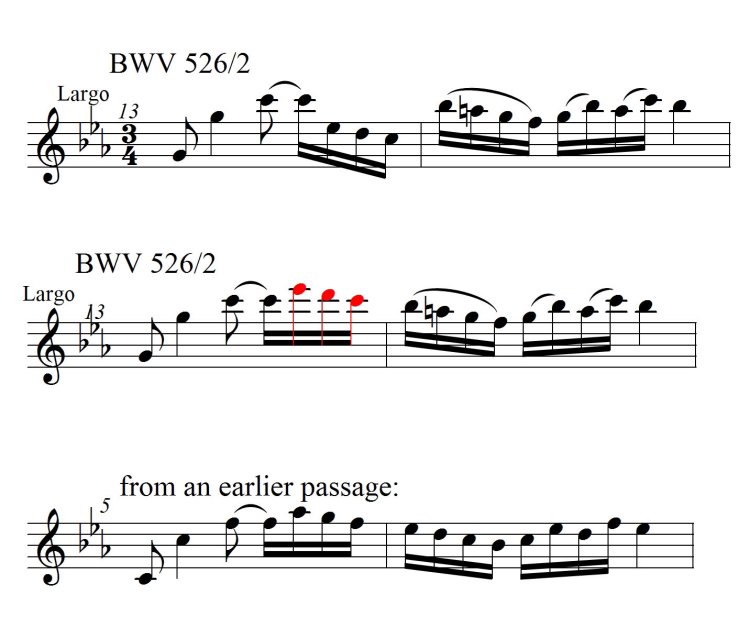
|
|
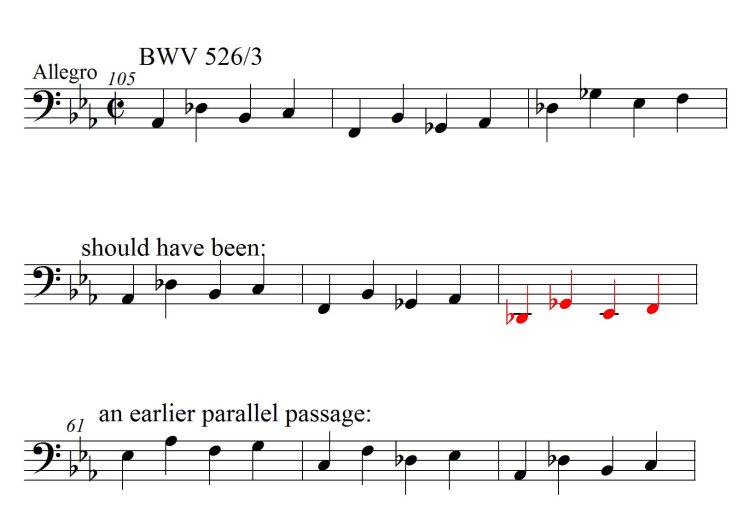
|
|
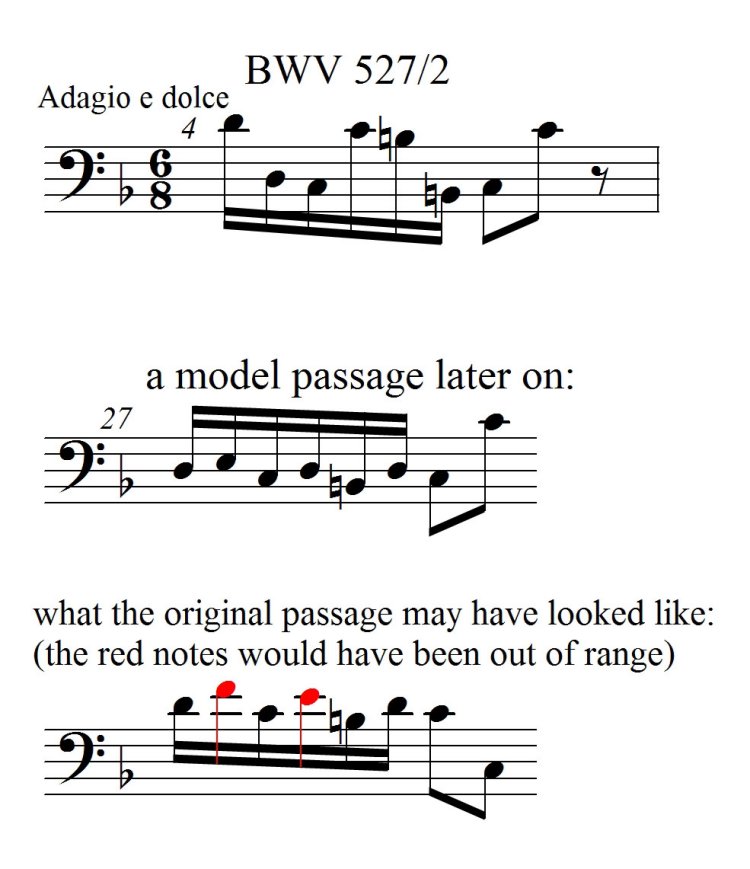
|
|
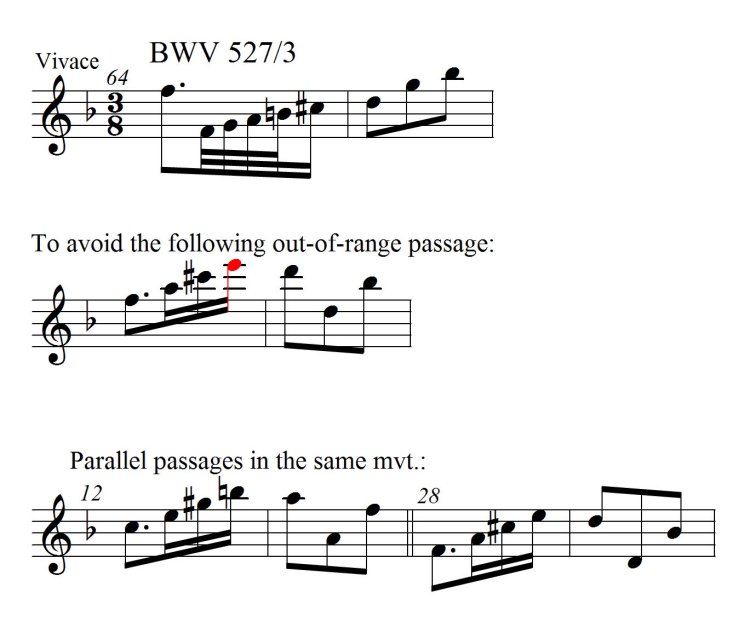
|
|
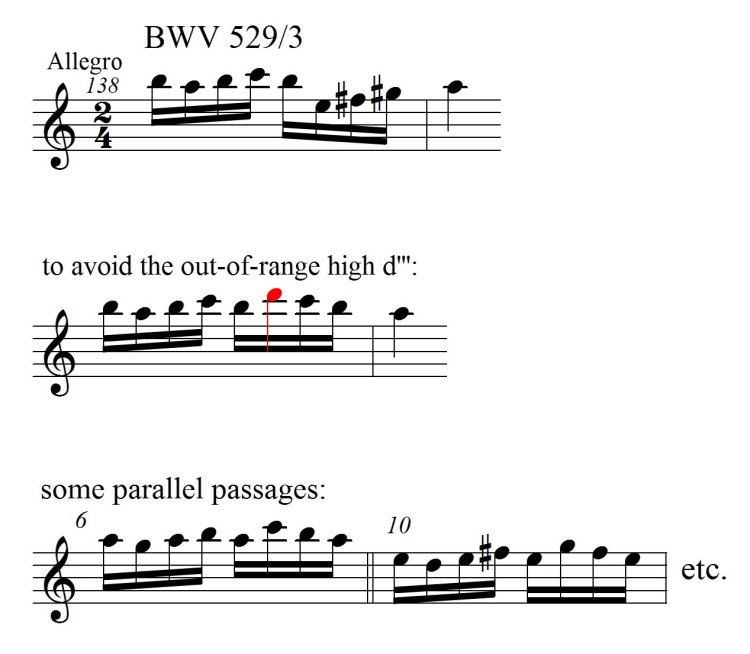
|
| |
|
The Early Printed Editions |
|
1. Kollmann, London, 1799: BWV 525 only
This is the first ever printed version of any of the organ sonatas in this set. It is appended as an example in an essay entitled: “An Essay on practical Musical Composition…by Augustus Frederic Christopher Kollmann, Organist of His Majesty’s German Chapel at St. James’s. London…M, DCC, XCIX”
On p. 99 the composition is introduced as follows: “An example…of a piece with a whole obligato part for Pedals, see at Plate LVIII. Trio by Sebastian Bach. This piece is taken from the said great Author’s collection of Organ Trios, and is calculated to be performed by one Person, on two sets of Manuals, and the Pedals….
The essay also contains other works by J. S. Bach: BWV 846 and BWV 870. Kollmann had also planned a complete edition of the Well-Tempered Clavier as well as all the Canons from BWV 1079 with their resolutions. A 2nd edition appeared in 1812.
A short biography of Kollmann
August Friedrich Christoph Kollmann (1756-1829) grew up in Hannover where he became acquainted with the Bach tradition as the pupil of Johann Christian Böttner (1731-1800) who was originally from Thuringia and was the organist at the Marktkirche, later the Schloßkirche in Hannover and also teacher at the Royal Seminary. In 1782 Kollman left for London where he became Cantor at the Royal German Chapel of St. James and, after a chamber organ had built there, also organist. Kollmann belonged to the oldest, active group of Bach admirers in England. He had direct contact with, among others, Charles Burney (1726-1814), Samuel Wesley (1766-1837) and Carl Friedrich Horn (1762-1830).
2. Wesley and Horn, London, 1809-1810
Title page for each trio sonata (they were issued separately):
A TRIO. | Composed originally for the | Organ. | By | John Sebastian Bach, | And now Adepted [sic] for | THREE HANDS | upon the | Piano Forte. | …To be had only of Mr. C. F. Horn…| and Mr. S. Wesley…| [signatures: S. Wesley | C. F. Horn]
An advertisement accompanying the first trio reads:
…Another of these Trios is preparing for the Press, and will very shortly appear, and it is proper to observe that no other English Impressions whatever, of any Part of this Author’s Works, are either genuine or correct but such as are signed, [signatures: S. Wesley | C. F. Horn]
There were two printings (editions): the first contained Sonatas I, II, III, and the second all six sonatas. The second edition also contained the following:
“To be had – of Mr. C. F. Horn…| at Mr. Birchall’s,… | Piano Forte Manufactory….”
The Bach-Jahrbuch (1906, p. 93) contains a reference to the Grove Music Dictionary of that time which reported an early edition of the trios as “6 Organ trios. London, Birchall. (ca. 1813)”. This must be identical to the second edition of the Wesley and Horn printing.
A short biography of Horn:
Carl Friedrich Horn (1762-1830) was a pupil of Christoph Gottlieb Schröter (1699-1782) in Nordhausen, Germany. He left for London in 1782 where, with the patronage and support of Count Brühl, an ambassador from Saxony to the English Court, he [Horn] obtained a position as a valet (1789) and quickly assumed the position of music teacher for the royal family. In this latter capacity, Horn had succeeded Johann Christian Bach who had died in 1782. In 1832 Horn became the organist at St. George’s Chapel in Windsor. In 1808, together with Samuel Wesley (1766-1837), Horn was successful in launching a Bach movement in England. Some of the goals of this movement were to publish a critical printed edition of Bach’s works and to found a Bach Society. From 1807 to 1813 Wesley and Horn published several works by Bach including particularly The Well-Tempered Clavier [the first complete editions of the latter were printed in 1801 by Simrock and another by Hoffmeister].
3. Nägeli, Zürich, 1827
This is one of Hans Georg Nägeli’s (1773-1836) earliest editions of Bach’s music.
Its title is:
Practische Orgelschule | enthaltend | Sechs Sonaten | für zwey Manuale und durchaus obligates Pedal. | von | Joh: Sebast: Bach. | Zürich bey Hans Georg Nägeli und Comp.
4. Peters I, 1st Edition prepared by Friedrich Conrad Griepenkerl, Leipzig, 1844
Edition Ia: undated
Edition Ib: after 1852
Edition Ic: Berlin, 1866-1867
5. BG 15 (1867), Editor: Wilhelm Rust
6. Peters I, 2nd Edition, Griepenkerl and Ferdinand Roitzsch, Leipzig, c. 1900 |
| |
|
Early Versions and Variants of the Individual Movements: |
|
[This listing is based upon the Sequence of Movements in the Autograph (P 271) {A} only. The letter “M” stands for scale limitations having been observed: see Oktavbrechung, Oktavknickung or Oktavversetzung above and what this implies. Frühfassung means ‘early version’.] |
|
Mvt(s). |
Version |
Comment |
|
I/1 |
Uncertainty about its original form |
|
|
I/1 |
Organ Trio in Bb major (Frühfassung) |
Only incipit survives |
|
I/1 |
Organ Trio in Eb major (Variant) |
M |
|
I/2 |
------ |
|
|
I/3 |
Uncertainty about its original form |
M in P 271 |
|
I/1+3 |
Instrumental Trio in C major |
M |
|
|
|
|
II/1-3 |
Uncertainty about its original form |
M in P 271 |
|
|
|
|
III/1 |
Instrumental Trio? |
|
|
III/1 |
Organ Trio in D minor (Frühfassung) |
M |
|
III/2 |
Uncertainty about its original form |
M in P 271 |
|
III/2 |
BWV 1044/2 (later version) |
|
|
III/3 |
Uncertainty about its original form |
M in P 271 |
|
III/1-3 |
“Sonata I” |
Mvt. 1: Frühfassung |
|
|
|
|
IV/1 |
BWV 76/8 (first version?) |
Autograph P 67 (1723) |
|
IV/2 |
Organ Trio in D minor (Frühfassung) |
|
|
IV/3 |
Organ Trio in E minor (Frühfassung), Fragment |
temporarily BWV 541/2 |
|
V/1 |
----- |
|
|
V/2 |
Organ Trio in A minor (Frühfassung) |
temporarily BWV 541/2 |
|
V/3 |
Uncertainty about its original form |
M in P 271 |
|
VI/1-3 |
------ |
|
|
|
|
|
Sonata I BWV 525 |
|
Bach’s handwriting for mvts. 1 and 3 appears to be more like a clean copy and a composing score while with mvt. 2 the situation seems reversed. However, this impression is very likely an illusion caused by the greater difficulty Bach encountered in writing out larger groups of notes.
In the autograph score of BWV 525/1, the first group of notes in m 2 is in an uncustomary manner written with their stems upward and the first three notes of the grouping of notes in m 6 irregularly has the stems going downwards – these instances point to relicts from an earlier version.
There are altogether five different versions of BWV 525/1:
The stemma would appear as follows: |
|
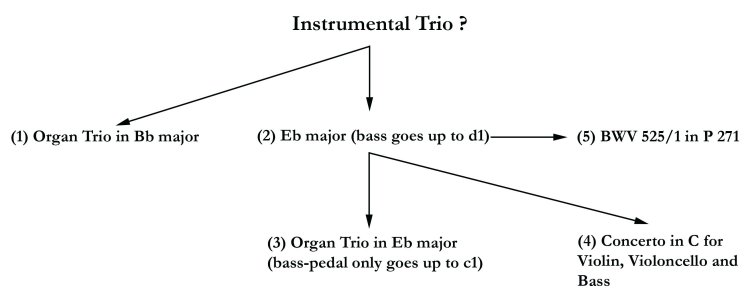
|
|
(1) Organ Trio in Bb major appears to have been derived from an instrumental trio for which the instruments being used are unknown. This organ trio is known only from an incipit which gives 2 and one-half measures. This early version underwent a thorough revision and a transposition to the key of Eb major. This new version (2) appears to have been the source of all subsequent versions (3), (4) and (5). The third version (3) was apparently revised to be played on an organ reaching only up to a c1 in the pedal, since those passages leading up to a d1 in the pedal were avoided by Octavknickung or Octavbrechung. The Concerto in C major, a trio for violin, violoncello and bass, has both BWV 525/1 and BWV 525/3. The latter movement may have served as the source for the autograph BWV 525/3.
More on (1) Organ Trio in Bb major: |
|

|
|
The 2 ˝ measure incipit comes from a handwritten thematic catalogue detailing the contents of a collection of manuscripts belonging to Carl Christian Kegel (1770-1843) who was a pupil of Johann Christian Kittel (1732-1809). Kegel was a teacher and organist in Gangloffsömmern near Erfurt. He obviously must have had connections with the Breitkopf publishers since several of his Bach manuscripts are now in the Royal Library in Brussels. It was François-Joseph Fètis (1784-1871) who had probably purchased them from Breitkopf in Leipzig and brought them to Brussels.
In the catalogue entitled: “Thematisches Verzeichniss der Compositionen für die Orgel und das Clavier von Johann Sebastian Bach, welche der Cantor Kegel in Gangloffsömmern besitzt” under the category “Für die Orgel”, both versions of BWV 525/1 (Bb major and Eb major) are listed. It is quite evident that the Bb major (1) is earlier than the Eb major version (2). The key of Bb major is unusual for an organ composition. It has been proposed that the Bb version (1) goes back to an earlier, now lost instrumental trio (see Bach-Jahrbuch, 1978, pp.54ff).
(2) The Variant Eb major Version for Organ also known as Trio a due Clav. e Pedale in Es:
This version exists in 8 separate sources. This version appears possibly to have been derived by revision and transposition to Eb major from the Bb major version (1) and agrees, for the most part, with the autograph (A) P 271. The pedal range of (2) is limited to only a c1 while the autograph BWV 525/1 has its range go up to d1. One of the Oktavbrechung instances in (2) appears to be the work of one of Bach’s pupils and not Bach himself. The earliest source of this variant (2) was copied by Anonymous 303, a copyist who worked for C.P.E. Bach in Berlin. It was probably copied from an original source (1) in C.P.E. Bach’s possession at the time.
(4) Concerto in C major or Trio for Violin, Violoncello and Bass contains BWV 525/1 (in C major), BWV 1032/2 (in A minor) and BWV 525/3 (in C major).
There is only one source available here: SPK Mus. ms. Bach St 345 (olim P 914) (in the Staatsbibliothek Berlin – Preußischer Kulturbesitz).
There are three parts with the title:
Concerto. | â | Violino. | Violoncello. | et | Basso. | del Sig. | J. S. Bach.
On the parts the mvts. are entitled:
1. Concerto (only on the violin and basso parts)
2. Largo (the violoncello part also has Dolce
3. Allegro
These manuscript parts probably date to about 1750. The watermark is unclear, the copyist has not been identified, and the origin or provenance of the parts has not been explained.
A new, printed edition of this music has been published:
Johann Sebastian Bach
Concerto in C-Dur (Triosonate) für Violine, Violoncello und Continuo. Hrsg. von Diethard Hellmann. B&H, Wiesbaden, 1965. Edition Breitkopf Nr. 6464.
This version does not appear to be an original composition by J. S. Bach since it involves a rather unusual combination of instruments for Bach. Most likely, it is an arrangement made by one of Bach’s students. The outer two mvts. agree essentially with those in BWV 525 except that they are in C major. The second part given to the violoncello is set an octave lower than the comparable part in BWV 525. The second movement of (4) is in A minor and corresponds essentially to the middle mvt. (in 6/8) of the Sonata for Flauto traverso and Harpsichord in A major, BWV 1032/2. According to the NBA KB VI/3, p. 44ff. the version for flute is clearly of a later origin than (4). The key sequence from mvt. to mvt. in (4) appears to be problematical. The middle movement of (4) has been obviously extracted from an original connection with other mvts. Unfortunately this original context is no longer ascertainable. Also, the outer mvts. of (4) show different scale limitations when compared with the middle (2nd) mvt. |
| |
|
Sonata II BWV 526 |
|
All three movements of this c minor sonata in Bach’s autograph exhibit a ‘clean copy’ showing, however, multiple corrections in the process. This raises the suspicion that Bach was copying from an earlier, no longer available, source. There is also evidence of scale limitations being imposed on the original musical lines (Oktavbrechung, Oktavknickung or Oktavversetzung). |
| |
|
Sonata III BWV 527 |
|
Frühfassung of BWV 527/1: Trio a due Clav. e Pedale in d
There are 6 manuscripts containing this mvt, but none of them are original. They point to a even older, missing source and to another intermediate source which is also missing. Of interest is the fact that two of these sources have mvt. 1 in the Frühfassung while the other mvts. are the same as those in Bach’s autograph. Also, both of these manuscripts have the title Sonata I. Apparently, when Bach was creating his autograph of the organ trios, he had a earlier source available to him which carried this title.
The oldest copies of the Frühfassung reveal that the score was created from separate parts, perhaps from an instrumental trio similar to the Concerto in C major (see above). Bach’s autograph copy of BWV 527/1 (Sonata III) is based upon an earlier version (Frühfassung) for organ, which in turn most likely originated from an instrumental trio.
The most important existing source for the Trio in D minor (Frühfassung) is a copy prepared by a Bach pupil, Johann Caspar Vogler (1696-c. 1765). The paper for the Vogler manuscript copy bears the same watermark used by Bach between 1727 and 1731. This manuscript is considered to have been a Hauskopie (not an official copy but one kept ‘in the house’ for private use). There are corrections on this score which may have been made by Bach. Very likely the Vogler score had been acquired by the Breitkopf Music Publishing Firm of Leipzig from the estate of Anna Magdalena Bach who died in 1760. Franz Hauser (1794-1870), a collector of Bach manuscripts, bought this Hauskopie from the Breitkopf Firm after 1830. Vogler also made another fragmentary copy of the same trio for his own use.
Versions of the 2nd Mvt. BWV 527/2
The autograph copy (P 271) of this mvt. with its evidence of Oktavbrechung, Oktavknickung or Oktavversetzung also reveals that Bach was working from an earlier version, perhaps an instrumental trio. This mvt. also appears later in a substantially newly revised version as the middle mvt. (in C major) of BWV 1044, the Triple Concerto for Flute, Violin, Keyboard, Strings and Continuo in A minor. Primarily the transmission of the latter work is through copies by some of Bach’s pupils probably in connection with performances given by Bach’s Collegium musicum after 1729. It had been assumed earlier that BWV 527/1 was the original source for BWV 1044/2, but since there are no examples in Bach’s oeuvre where he transcribed compositions with obbligato instruments to create other compositions using different obbligato instruments, it is more reasonable to think that both mvts. go back to a yet older version of an instrumental trio that has been lost. |
| |
|
Sonata IV BWV 528 |
|
It is obvious from the corrections that Bach made in all three mvts. of this Sonata in E minor that he was relying on earlier versions.
Frühfassung of Mvt. 1
The first mvt. of Sonata IV corresponds to the Sinfonia (mvt. 8) from the second part of the cantata BWV 76 “Die Himmel erzählen die Ehre Gottes”, Bach’s second Leipzig cantata dated 1723 in the autograph score. There, in the score, is a considerably corrected version for Oboe d’amore, Viola da gamba and Basso. The question that this raises is whether all these corrections result from a ‘composing’ score or from the numerous revisions entailed in working from an earlier version. This mvt. could possibly have had BWV 76/8 as its original source, or both versions look back to a common source which is even older.
Frühfassung of Mvt. 2, BWV 528/2
Trio a due Clav. e Pedale in d
Three versions point back to a single Frühfassung in D minor (the later veis in B minor). Of these the oldest was probably copied circa 1760 and belonged to the Breitkopf collection (it may have been copied from a lost manuscript that could be attributed to Johann Tobias Krebs during Bach’s Weimar period). The source for the Peters Edition (I) is unknown.
Fragment BWV 528/3
This crossed-out fragment consisting of 13 measures must have been among the materials Bach had at his disposal when he was writing out his autograph versions of the Organ Sonatas. It is discussed at length in the NBA KB IV/5-6, pp. 433ff. and is considered an earlier attempt by Bach (the Un poc’allegro was still missing but the rest of the fragment agrees with Bach’s later autograph version – it is possible that the phrasing markings were added later by someone else who thus made it conform with the autograph). |
| |
|
Sonata V BWV 529 |
|
All three mvts. of the autograph of BWV 529 are of the type ‘clean copy’ with some corrections. This indicates that all of them are a reworking of earlier, already existing sources. The third mvt. shows evidence of Oktavbrechung, Oktavknickung or Oktavversetzung. The only Frühfassung that exists is that for the second mvt. which temporarily served as the middle mvt. of the Prelude und Fugue in C major, BWV 545.
Trio a due Clav. e Pedale in a
The Frühfassung of BWV 529/2 (printed version available in NBA IV/4, pp. 16-19)
There are still eight manuscripts available of which the eldest (as the middle mvt. of BWV 545) copied by Johann Gottfried Walther (1684-1748) would conceivably place the date of composition during Bach’s Weimar Period. Other copies appear to have been copied from the autograph of BWV 545 which has been lost. |
| |
|
Sonata VI BWV 530 |
|
There are numerous corrections made in the autograph (a ‘composing score’), particularly for the first movement (BWV 530/1), however, no earlier versions for any of the movements or other evidence of their existence have been discovered. |
| |
|
[based upon NBA KB IV/7, prepared by Dietrich Kilian, (Bärenreiter, 1988), pp. 13-112]
Contributed by Thomas Braatz (September 8-25, 2008) |
|
Trio Sonatas BWV 525-530 : Details
Reviews of Individual Recordings: Trio Sonatas - Biggs | Trio Sonatas - Johanssen & Lippincott | Trio Sonatas - London Baroque
General Discussions: Part 1 | Part 2 |
|
|